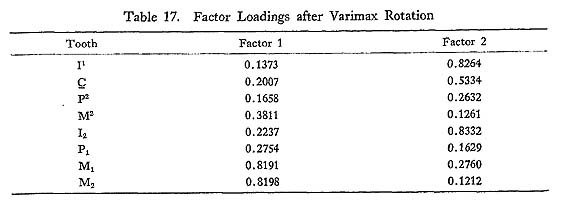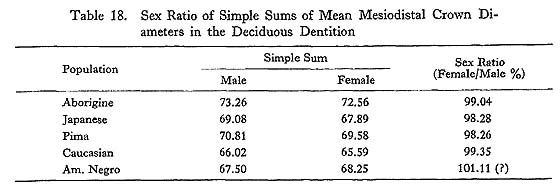4. TOOTH CROWN MEASUREMENTS
4.2. Sex Difference in Mesiodistal Crown Diameters as a Whole
|
In order to compare the sex difference in terms of overall size of dentition among different populations, Hanihara (1974) computed Mahalanobis' generalized distances between male and female groups using mesiodistal crown diameters in I1,C , P2, M2, I2, P1, M1 and M2. This calculation was based on a pooled dispersion matrix of five populations, Aborigines, Japanese, Pimas, Caucasians and American Negroes, so that the distances between male and female groups were directly compared in a common multi-dimensional space. Table 16 shows that all the distances are statistically significant under the 1% level. However, between-sex distances are somewhat different among the populations involved; namely, the distances are evidently smaller in some populations than in the others. This shows quite likely that between-sex differences in overall tooth size, not in individual tooth size, are much smaller in Aborigines and Japanese than in Pimas, Caucasians and American Negroes.
Hanihara further goes to compute canonical variates based on the generalized distance using Rao's method (1952). The purpose of this procedure is to make relationship between male and female groups more evident. The generalized distances shown in Table 16 are those in the nine-dimensional space, because ten groups in total are compared in combination so that the location of each group in such a space is hardly recognized in reality. However, it is possible to project all the groups to a space of reduced dimensions by using canonical variates. In the present case, if the first and second canonical variates are taken into account, they may contain about 77% of the total informations which could be obtained from the samples. This means that a graph drawn on the basis of two sets of canonical variates may be equivalent to a projection of ten groups to a two-dimensional space with a loss of about 23% of total variance (Figure 1).
The results seem to be quite suggestive. In the first place, the distances between males and females are relatively small in Japanese and Aborigines, and larger in the other three populations. This agrees quite well with the results obtained from the direct com parison of the generalized distances. Secondly, it may be realized that the inclination of the lines connecting male and female groups varies from population to population; namely, the inclination is relatively steep in Japanese and Pimas, but much more gentle in the other populations. In other words, between-sex difference is almost the same in both directions of the first and second canonical variates in the former two populations, but the difference is particularly large in the direction of the first canonical variates in the latter populations. This seems to mean that the between-sex difference is not the same in all the populations, because the two sets of canonical variates represent different factors which concern the tooth crown size, and they are uncorrelated with each other. In the second step of this study, Hanihara carried out factor analysis of the mesio distal crown measurements to interpret the meanings of the first and second canonical variates. Table 17 shows factor loadings after orthogonal rotation using varimax method. Factor 1 represents significantly higher correlation with the mandibular molars, and less but still significant correlation with the maxillary molars. On the other hand, Factor 2 shows higher correlation with the incisors, and somewhat less with the maxillary canine.
Based on these results, it is quite evident that the size of molars largely contributes to the Factor 1, and that of incisors to the Factor 2. On the other hand, the premolars show almost no correlation with either Factor 1 or Factor 2. This seems to mean that the premolars could be represented by some other factors. Since the canonical variates and the factor loadings have been calculated from the same samples, rates of contribution to the total variance are likely to parallel each other, and this supposition is proved by comparing a graph drawn from the canonical variates on one hand, with that from mean factor scores on the other. The graphs, which are quite similar to each other, show that the between-sex difference is particularly large in size of the molars and relatively small in that of the incisors as well as the canines in Abo rigines, Caucasians and American Negroes. On the other hand, almost the same extent of difference is shown by the front teeth and the molars in Japanese and Pimas. As a whole, Aboriginal permanent dentition is similar to Japanese in its relatively small between-sex difference, but to Caucasians and American Negroes in its pattern of difference to which the molars largely contribute in comparison with the front teeth. Pimas are quite different from Aborigines in both aspects. In regard to the sex difference in the deciduous dentition, no calculation of gen eralized distance was carried out because the numbers of teeth were so small in some populations that reliable results could hardly be obtained. Instead of this, the present author compared male and female groups using a simple method to guess general trends of between-sex difference. The method employed is 1) to calculate simple sum of mean mesiodistal crown di ameters in each group, and 2) to compare them by calculating the 'sex ratio' between male and female groups, or the percentage of the sum of female group to that of male group. Table 18 shows that the 'sex ratio' distributes within a very narrow range of percentages. This means probably that the between-sex difference varies little from population to population. The simple sums for American Negroes are larger in female group than in male group so that the 'sex ratio' reaches more than 100%. However, this result may be caused by the very small number of front teeth, most of which were replaced by permanent teeth.
However, it is of interest to note that Aborigines show relatively small between-sex difference compared with Japanese and Pimas. This trend is quite similar to that of the permanent dentition. Although this simple method of comparison does not reveal rates of contribution of each factor which controls general size of the deciduous dentition, comparison of mean mesiodistal crown diameters in male and female groups may show some trends of contribution of each tooth to the between-sex difference. In the deciduous incisors and canines, the mean values of the female group are almost the same as or a little bit smaller than those of the male group. However discrep ancies between the sexes are somewhat larger in the deciduous molars. This trend is shown by the fact that, in the deciduous molars, the mean values for females amount to 92-98% of those for males. On the other hand, the ratios between male and female groups are almost equal, being around 98%, in every deciduous tooth in Japanese. These results are likely to show that the pattern of sex difference is somewhat dif ferent between Aborigines and Japanese. Namely, contribution of the deciduous molars to the sex difference is particularly large in Aborigines, while almost the same as that of the deciduous incisors and canines in Japanese. This trend is quite .similar to that of the permanent dentition described above, and suggests that, among different popula tions, some discrepancies in pattern of contribution of each tooth or tooth group to between-sex difference exist in both permanent and deciduous dentitions. |



